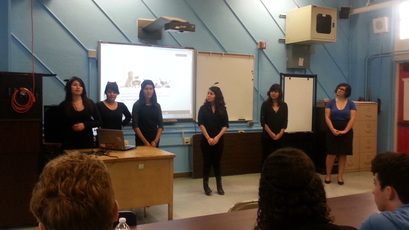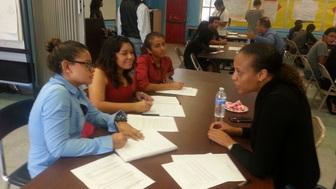Through the WASC process we analyzed the trends in student progress and worked as a high school team to focus on the critical academic needs of vocabulary development and question analysis. We looked at the content strands with the greatest growth and lowest scores to help hone our overall themes to reinforce and improve performance. Through this research and awareness we saw our CAHSEE pass and proficiency rate increase in the past three years.
The teachers and I began to proactively and organically connect our schoolwide learning goals of being an effective communicator, problem solver, personally and socially responsible, and technologically literate into the curriculum. This has helped not only improve the ethics and maturity of the students but it also helps relate all assignments back to the real world skills we are trying to practice and sharpen through the International Baccalaureate model.
For my classroom assessments, I have discovered Edmodo.com and Google Forms to help monitor student progress and differentiate instruction. Through Edmodo, a social networking site for classrooms, the students can see every assignment, comment on their scores and keep track of everything they have done or need to do. The power is now in their hands and they can monitor their own progress. Another perk is that I can easily add polls, quizzes or send out individual assignments to students. This tool has empowered the students and helped me quickly assess where scaffolding and extra support is needed.
This past semester, I started teaching Scratch - a beginning programming tool where "young people learn to think creatively, reason systematically, and work collaboratively." It is a great program, but one that I only just learned about and have not had the time to become an expert prior to introducing it to my students. Lucky for me, I was g
Another added benefit is that I have added mentors and teachers to some of my Edmodo classes so they can comment and critique specific assignments as well as participate in common scoring. This involvement has increased the quality of student participation immensely. We also use Google Forms for partners to rate student work as well as compile reflections after large projects.
I use my business partners as mentors on a regular basis so that the students get real world feedback about the quality of their work and their writing. The seniors present their final ad campaign projects to executives in the company’s conference room as well as defend their digital portfolios in a group of peers and ad agency mentors. Their final grade is based on the scores from the audience of professionals. The juniors send their resumes and cover letters to human resource professionals and writers in order to get feedback about how they can improve. The students now vote for their peers to determine who has the best projects and the winners are celebrated on our website and at our end of year “Techies got Talent” event.
All of these methods raise the level of expectation in the classroom and connect the students to our schoolwide learning goals. They quickly learn that laziness does not cut it and that others’ perception of the quality of their work matters. Making the classroom more student centered has also given me more time to move through the classroom, gauge understanding and interact more personally with each student. As a result, I now have students who are certified in Microsoft Office programs, Internet and Core Computing Certification and setting their own goals and projects to go further in programming, video and graphic design.


 RSS Feed
RSS Feed
